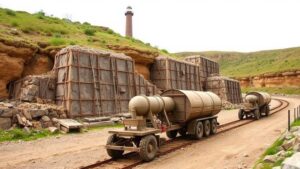Leveraging AI to Simulate Historic Earthquakes for Fossil Exposure Predictions
Leveraging AI to Simulate Historic Earthquakes for Fossil Exposure Predictions
The investigation of past seismic events is critical for understanding the geological and paleontological landscapes of Earth. With advancements in Artificial Intelligence (AI), researchers are now able to simulate historical earthquakes, providing valuable insights into fossil exposure patterns. This article delves into the methodologies, applications, and implications of using AI in simulating earthquakes and predicting fossil exposure.
1. Introduction
Earthquakes have shaped the geological structures of our planet and influenced the distribution of fossils buried within sediment layers. Traditional methods of studying these events involve historical geological assessments and paleontological records, which can be time-consuming and often yield incomplete data. AI technologies, particularly machine learning algorithms, have emerged as a promising tool to enhance the accuracy of simulations relating to historic seismic activity and its effects on fossil exposure.
2. Historical Context of Earthquake Simulations
Over the past several decades, advancements in seismology have led to significant breakthroughs in our understanding of earthquakes. For example, the 1906 San Francisco earthquake, which reached a magnitude of 7.9, caused vast destruction and altered the landscape dramatically. Such earthquakes provide a foundation for understanding how future events might influence fossil exposure and geological formations.
3. Methodologies for AI-Based Earthquake Simulation
AI can be utilized to simulate earthquakes by employing large datasets of historical seismic activity and geological features. The methodology typically involves the following steps:
- Data Collection: Researchers gather data from seismic records, geological surveys, and remote sensing technologies.
- Model Training: Machine learning models, particularly neural networks, can be trained on this data to recognize patterns and predict potential outcomes of seismic events.
- Simulation Execution: Once trained, models can simulate various earthquake scenarios, assessing their impacts on geological structures and potential fossil exposure.
4. Case Study: The 1960 Valdivia Earthquake
The 1960 Valdivia earthquake in Chile, registered at a magnitude of 9.5, remains the most powerful earthquake ever recorded. Utilizing AI simulations, researchers can analyze the resulting seismic waves and ground deformation, allowing them to predict which fossil deposits might be exposed due to the earthquakes effects. This approach not only enhances our understanding of the quake but also assists paleontologists in locating previously unseen fossil deposits.
5. Real-World Applications of AI Simulations
The implications of AI in simulating historic earthquakes extend beyond academic research. Key applications include:
- Fossil Tourism Development: Regions with high fossil exposure potential can be developed into educational tourism sites, attracting geology enthusiasts and enhancing local economies.
- Environmental Management: Understanding where fossils may become exposed can help in regional planning and conservation efforts, minimizing human impact on sensitive geological sites.
- Natural Disaster Preparedness: Insights gained from simulations can be used to bolster community preparedness programs in earthquake-prone areas.
6. Challenges and Limitations
Although the prospects of using AI to simulate earthquakes are promising, several challenges remain:
- Data Limitations: Access to comprehensive and high-quality historical data can be limited, affecting the accuracy of simulations.
- Algorithmic Reliability: Machine learning models require rigorous testing to ensure their predictions are reliable and function effectively in varying scenarios.
7. Conclusion
The utilization of AI in simulating historic earthquakes represents a significant advancement in both the fields of geology and paleontology. By harnessing historical data and sophisticated algorithms, researchers can predict fossil exposure with increased accuracy. Future research should focus on overcoming current limitations and expanding the scope of AI applications in this essential area of study. As the intersection of AI and geology continues to evolve, it holds the potential for transformative impacts on how we understand Earths past.
8. Actionable Takeaways
- Researchers should continue to enhance AI algorithms with diverse datasets to improve the accuracy of simulations.
- Collaboration between geologists, paleontologists, and computer scientists is necessary to fully realize the potential of AI in this field.
- Educational institutions and local governments should consider leveraging AI findings to promote sustainable tourism and conservation efforts.
This integration of AI in the study of historic earthquakes will not only deepen our understanding of Earth’s geological history but also contribute to more informed decision-making in environmental management and fossil conservation.



